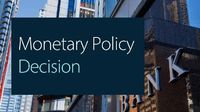Australia’s economic landscape shifted again on August 12, 2025, as the Reserve Bank of Australia (RBA) cut its benchmark interest rate by a quarter percentage point to 3.6%. This marks the third such reduction this year, a move widely anticipated by market watchers and economists alike, as inflation continues its downward trajectory and economic growth remains sluggish. The RBA’s decision, which brings the cash rate to its lowest point since March 2023, reflects both domestic and international pressures that have shaped the nation’s financial outlook in recent months.
The RBA’s board made the rate cut unanimously, a sign of confidence in the decision after months of waiting for clearer signs that inflation was easing. According to Reuters, the bank’s governor, Michele Bullock, highlighted the ongoing uncertainties in the world economy, particularly around international trade policy. Yet, she also noted, “There is a little more clarity on the scope and scale of U.S. tariffs and policy responses in other countries, suggesting that more extreme outcomes are likely to be avoided.”
The cut from 3.85%—itself a reduction from 4.1% in May and 4.35% in February—was not just a technical adjustment. It’s a signal that the RBA is determined to keep inflation within its target band of 2% to 3%, while also trying to avoid tipping Australia into a recession. The latest inflation figures suggest that this strategy is working, at least for now. Annual inflation fell to 2.1% in May, down from 2.4% a month earlier. The trimmed mean, the RBA’s preferred measure for underlying inflation, dropped from 2.8% in April to 2.4%—a significant retreat from the peak of 7.8% in late 2022. These numbers, reported by the Associated Press, are the lowest since March 2021 and put inflation near the lower end of the RBA’s range.
But while inflation has been tamed, Australia’s economic growth has clearly lost momentum. The economy grew just 0.2% in the first quarter of 2025, and only 1.3% year-on-year, both well below forecasts. The RBA has now downgraded its growth outlook for the year to 1.7% from the earlier prediction of 2.1%. As Katherine Keenan, head of national accounts at the Australian Bureau of Statistics, explained to Reuters, “The soft growth was due to shrinking public spending and weakened consumer demand and exports.”
Unemployment is also on the rise, creeping up to 4.3% in June from 4.1% earlier in the year. The jobless rate had held steady at 4.1% since February but has now moved higher as the labor market eases from previous full employment levels. Still, consumer spending is beginning to show signs of life, thanks in part to the cumulative effect of lower inflation and previous tax cuts. According to Oxford Economics Australia’s Harry Murphy Cruise, “Unemployment has jumped, strengthening the case for cuts. At the same time, robust household spending shows some families can still find room for discretionary purchases. In the end, prices and jobs trump everything else. With good news on inflation and bad news on unemployment, more easing is warranted.”
The global context is never far from the minds of policymakers. U.S. President Donald Trump’s decision on August 11, 2025, to extend a tariff truce with China by another 90 days has helped stave off a feared escalation in the trade war, according to Reuters. While Australia remains subject to a baseline 10% U.S. tariff, the RBA noted that “recent international trade policy developments have had little discernible impact on the Australian economy to date.” Still, the central bank warned that “a more material disruption to global trade cannot be ruled out.”
Financial markets responded predictably to the news. Australia’s S&P/ASX 200 equity index edged up about 0.3% after the rate cut was announced, while the Australian dollar weakened slightly—down 0.15% to 0.6501 against the U.S. dollar. Bond markets also reversed earlier losses, with three-year bonds climbing in value as investors bet on further easing.
Indeed, the RBA has hinted that more rate cuts could be on the horizon. Governor Bullock said, “Forecasts imply that the cash rate might need to be a bit lower than it is today to keep inflation low and stable and employment growing but there is still a lot of uncertainty.” She emphasized that future decisions would be made on a meeting-by-meeting basis, depending on the latest data. Analysts at the Commonwealth Bank of Australia, cited by Reuters, predict another rate cut in November and possibly one more in early 2026. Marcel Thieliant of Capital Economics expects the cash rate could fall to 2.85% by mid-2026, based on the RBA’s reduced inflation forecasts.
The path to this point has not been straightforward. In July, the RBA surprised markets by holding rates steady in a split decision, with the majority of policymakers wanting to wait for more inflation data. When the numbers finally arrived, they confirmed that inflation was easing towards the midpoint of the target band, paving the way for this week’s cut. The bank’s cautious approach—cutting only after quarterly inflation data—has been a hallmark of its recent strategy, aiming to avoid both runaway inflation and a sharp economic downturn.
Treasurer Jim Chalmers welcomed the move, telling reporters, “This is very welcome relief for millions of Australians. It will put more money in the pockets of people who are under pressure.” The sentiment is echoed by many households and businesses, especially those feeling the pinch of higher living costs and stagnant wage growth.
Yet, challenges remain. The RBA’s own outlook acknowledges persistent weak productivity as a key headwind. The lower growth forecast is attributed more to this productivity slump than to trade disruptions, and the central bank has made clear that it will act again if needed to support both price stability and employment.
As Australia heads into the final months of 2025, all eyes will be on the RBA’s next moves. With inflation at bay but growth and jobs under pressure, the central bank is walking a tightrope—balancing relief for borrowers against the need to foster sustainable economic expansion. The coming quarters will test whether this careful approach can deliver the stability and prosperity Australians have come to expect.

